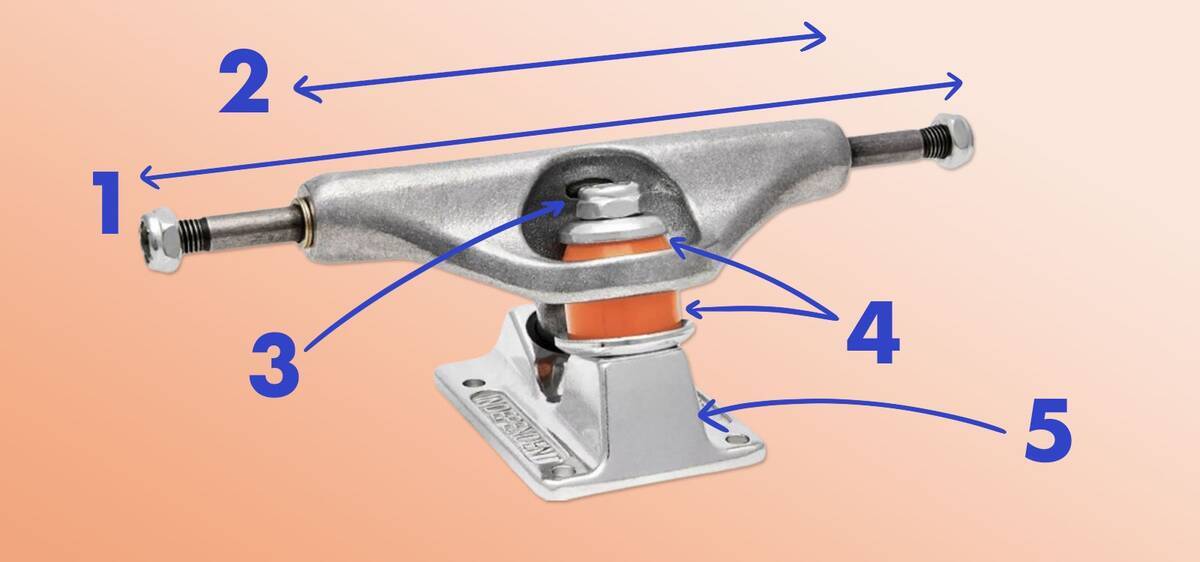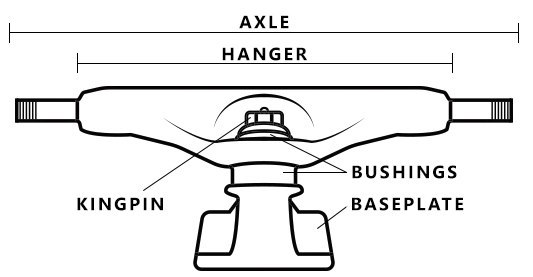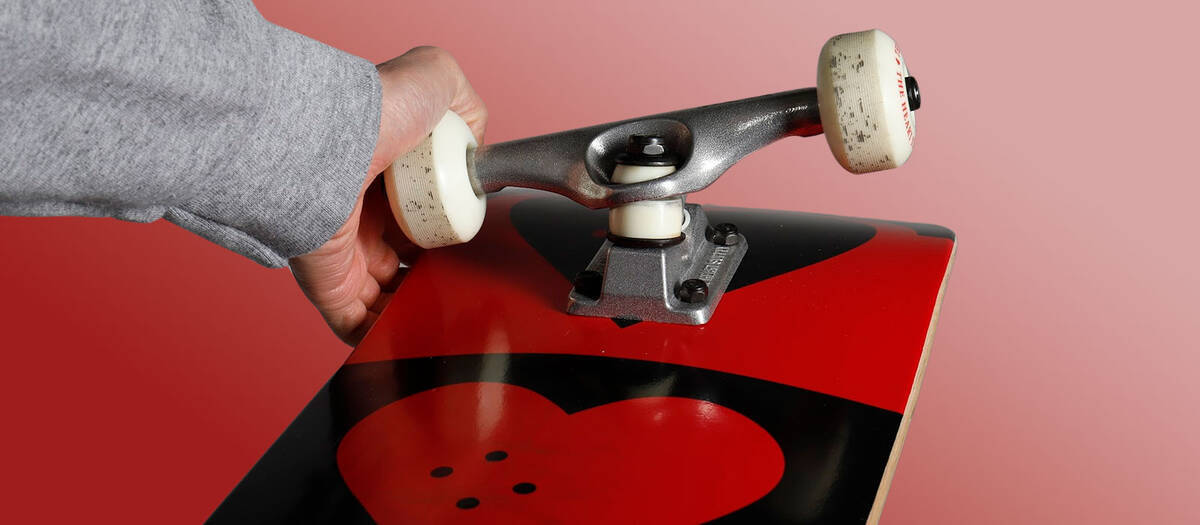Guide to Buying Skateboard Trucks
Selecting skateboard trucks might seem overwhelming, yet opting for a reliable truck manufacturer and ensuring the right size for your deck generally results in a purchase you’ll be satisfied with. For those purchasing a complete skateboard, trucks are pre-installed, sized precisely to fit the overall setup.
Overview
Understanding Skateboard Truck Components

To begin, it’s important to understand the fundamental parts. So, what are skateboard trucks? Essentially, these are T-shaped metal structures fixed underneath your skateboard deck, holding the wheels in place. They comprise two principal components rotating against each other: the baseplate and the hanger, secured together by a kingpin bolt, which also holds the bushings. Here is a detailed look at the main elements of a skateboard truck:
Baseplate
Mounted firmly to the deck with four bolts, the baseplate is a flat metal part crucial for even weight distribution and shock absorption during landings. Pivot cups located within these baseplates enable the hanger to pivot, thus affecting how smoothly you turn. As the connecting piece between the deck and hanger, the baseplate is pivotal to both the truck and your overall setup.
Hanger
The largest part of a skateboard truck is the truck hanger. Forming an oblong bar that narrows to a triangle at the pivot, it slots into the pivot cup in the baseplate. The hanger’s contact with rails and ledges in grinds is significant in achieving grind tricks.
Axle
The axle is an extension through the hanger, with threading on its ends to secure the wheels via nuts. These outer threads may wear out (especially with frequent rail stands), but tools exist to re-thread them. Many T-tools feature 5/16" axle re-threaders, a handy solution if re-threading your trucks has been necessary in the past. Explore our collection for a suitable skate tool:
Kingpin
A central large bolt, the kingpin connects all truck parts together. Adjusting the kingpin nut allows you to change the tension of your trucks. While kingpins can break under pressure, they are replaceable.
Truck Bushings
Bushings, the rubbery cushions nestled between the baseplate and hanger, convey pressure from your feet to the hangers, impacting your setup’s agility. Bushing firmness determines turning capability:
- Hard bushings: Make trucks more stable if they become wobbly, requiring more effort to initiate turns.
- Soft bushings: Perfect for carving, cruising, and those who prefer responsive, loose trucks.
Discover how to install skateboard bushings, or browse for new bushings, washers, or hardware:
Now that you understand the components of a skateboard truck, let’s consider essential factors in selecting the right trucks for your skateboard.
Dimensions of Skateboard Trucks & Measurement Techniques

Characteristics of skateboard truck sizes involve two facets: width and height. Here’s a basic overview to assist you in determining an appropriate size for your skateboard trucks.
Truck Width

Aligning your truck width with your deck width is crucial. Deviations between truck and deck widths can lead to instability or hinder shoe movement during tricks.
Manufacturers specify truck sizes based on hanger width minus axle width, while overall width involves the axle measurement you should match with your deck width.
SkatePro provides exact axle width details for each truck selection, eliminating the need to convert truck sizes using a skateboard size chart.
Truck Height

This refers to the elevation from the baseplate to the axle centres and impacts the gap between deck and wheels, as well as the deck's height from the ground.
Skateboard trucks are categorised into height levels – high, medium, or low – offering straightforward decision-making. Here are their attributes:
- Low Trucks (46-49 mm): Easy handling likens them to users who appreciate increased stability and who are beginners or have shorter leg spans. Avoid wheels over 53 mm without risers.
- Mid Trucks (49.5-53.5 mm): A balanced option between high and low variants, these suit general skating activities but wheels should not exceed 56 mm unless risers are added.
- High Trucks (53.5-60mm): Allowing larger wheels, these are excellent for cruising and freestyle skating, enhancing ground clearance and balance during rail stands.
Each truck in our assortment is listed with height specifications.
Considerations for Truck Height - Overview of Key Variables
Choosing truck height revolves around personal taste influenced by skating style and physical factors. Consider these aspects when deciding between higher or lower trucks:
- Wheel clearance: Higher clearance facilitates carving and deep turns, whereas tight setups require less. Ensure ample clearance if preferring loose trucks.
- Pop angle: Height influences pop angle, with lower trucks improving response and agility, while higher angles aid larger tricks.
- Pushing: Greater heights increase distance between pushing and deck feet, reducing pushing comfort for extended skate sessions.
- Tricks: Truck height affects trick performance, with high trucks beneficial for balancing, while low trucks offer flatland trick agility.
- Truck weight: Larger trucks are heavier due to increased dimensions.
- Personal height: Taller individuals might prefer higher setups for greater control.
Riser Pads - Adjust Truck Height to Prevent Wheel Bites

Riser pads effectively resolve wheel bite issues, which occur when wheels contact the deck during sharp manoeuvres, by increasing distance between the deck and wheels.
For those interested in experimenting with larger wheels or loosening trucks, riser pads may also prove useful.
Our range of riser pads is available for skateboarders seeking to address wheel bite complications or optimise their setup:
Ensure correct hardware for riser pad installation. Refer to the guide below for any hardware length uncertainties:
Weight Considerations for Skateboard Trucks: Heavy vs. Light
Trucks contribute significantly to a skateboard’s total weight, and lightening strategies in truck design, like hollow kingpins and axles and different materials, focus on weight reduction.
Currently, Tensor Mag Light Series claims to be the “lightest trucks ever” available. This lighter weight benefits trick performance, though differences in weight are not as evident as other truck features.
Truck weight is related to truck size, with larger trucks having more mass than their smaller counterparts. Evaluate truck weight alongside wheel and deck dimensions.
Adjusting Skateboard Truck Tension – How to Modify Tightness

For truck tension adjustments, use a skate tool or standard tool to tighten or loosen the kingpin nut. Tightening requires more effort to turn, whereas loosening enhances agility. Truck tension ultimately suits your skating style and personal preferences.
Experimenting and practice are needed to find your preferred truck tension as it affects turning dynamics. Carry a skate tool to try various settings while skateboarding.
When to tighten your trucks:- Wheel bites occur during turns or upon landing tricks.
- Consistent pop is desired.
- Stability issues arise at high speeds or post-tricks.
- You're lifting the front wheels to make turns.
- You aim for more precise turning.
- You sense restriction and wish for greater lateral freedom.
Your turning and carving ability is also influenced by the hardness of your bushings. These are available in various hardness levels, typically indicated on the durometer scale. A higher durometer signifies harder bushings, which result in tighter trucks. View our range of bushings:
Steps to Fit Skateboard Trucks
Each truck is fitted using 4 nuts and 4 bolts. We advise tightening the bolts in a cross-diagonal sequence to ensure even tightening of the baseplate over the entire surface.
We're always here to assist you:
